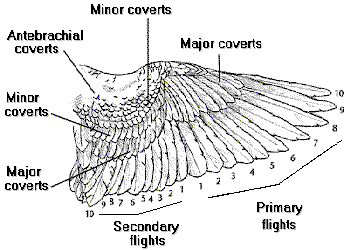Bird owners are often advised to clip the wings of their birds. A common first reaction is that it is a cruel thing to do. After all, birds are meant to fly. However, there are valid reasons for clipping. First and foremost is the bird’s safety, but there are other reasons as well.
Safety – Unclipped birds can easily panic and fly into windows, glass doors, or mirrors, injuring themselves. They can fly into kitchens and land on hot stoves, burners, and pans. They can fly into overhead ceiling fans or dangerous electrical appliances. Small birds, able to get into smaller spaces, have flown into open cupboards and drawers and been locked in or have gotten trapped behind refrigerators. Others have drowned in open toilet bowls.
We have all heard that ‘Curiosity killed the cat’. This old adage applies to your birds too. There are many things around our homes that are toxic or dangerous to birds, lead paint, household cleaners, etc. A flighted bird can reach such items more easily. There is no end to the number of dangerous and lethal items that your bird may find attractive, edible and/or perchable.
Loss Prevention – For most of us, losing our bird would be a very painful thing. It would be even worse if the loss could have been prevented. An open door or window is an invitation to an unclipped bird. No matter how tame, birds will fly out and may be lost forever. Some of us take our birds out in the sun or transport them to the vet or take them with us on a trip. In all these situations, no matter how careful we are, an opportunity to fly away may present itself. Clipping a bird’s wings is an easy way to reduce the possibility of such a loss.
Training – Birds, like children, must be taught where they are allowed and where they are not allowed. They should be trained to stay, when placed on a gym or other permissable area. A bird with clipped wings will be more likely to stay where you place him.
Behavior – Some birds are more aggressive and difficult to train. Many people find that clipping a bird’s wings diminishes aggressiveness and makes a bird easier to work and play with. Our wild caught cockatoo used to fly up to the beams in our cathedral ceiling when scared by a flock of birds outside our den window. Since his wings have been clipped, he has become accustomed to outside activity and now screeches back at the “intruders”.
Protecting Your Home – Before we began clipping our birds’ wings, we had thousands of dollars worth of damage to our home. Our two innocent little conures, successfully destroyed the wooden window frames, screens, doorframes, and doors in our bedroom. Our cockatoos have taken huge chunks out of a few window and door frames as well. One of our cockatoo’s favorite joys is making holes in vacuum cleaner hoses. Now that the birds’ wings are clipped, the daily piles of wood shavings have disappeared from our bedroom floor.
Breeding – In some species the male has been known to attack the female. Clipping the male’s wings while leaving the female fully flighted can help protect the female by enabling her to more easily escape an attack.
The First Clipping
Baby birds should not be clipped until they have learned to fly. Learning to fly gives birds confidence, enables them to properly develop their chest muscles, teaches them balance and enables them to learn how to turn and to land safely. Being able to manuever and land properly is very important. Birds have very light, fragile bones which can easily be injured by a clumsy landing or a fall.
When to Clip
Birds should be clipped when their feathers have grown back enough so that they can fly more than a few feet. This is usually after a molt and for most birds about once a year. If clipping is done during a molt, then some of the clipped feathers may still continue to grow out. New feathers may also grow in as well. If you wait until the molt is complete there should be a need for only one clipping. However, if your bird is flying, you may not be able to wait and can do multiple clippings.
What and How Much to Clip
After clipping a bird should still be able to fly a few feet. This enables him to protect himself from a fall, by giving him enough lift to land safely. If clipped too drastically, he won’t be able to maneuver to avoid hitting something dangerous or to break his fall. As a result he may injure his beak, breastbone or wings or even break a leg as he plummets to the ground.
 The only feathers which should be clipped are the primary flight feathers. These are the ten long feathers on the outermost part of the wing. Start at the 10th primary (the one furthest from the body) and progress inward. How many primaries you need to clip varies by species and bird.
The only feathers which should be clipped are the primary flight feathers. These are the ten long feathers on the outermost part of the wing. Start at the 10th primary (the one furthest from the body) and progress inward. How many primaries you need to clip varies by species and bird.
Feathers should be trimmed back so that the cut end is just under the major coverts. The coverts will thus surround the rough edges and help prevent them from irritating the skin. This is very important, as birds may begin feather plucking if the trimmed feathers are irritating.
Don’t clip the feathers on only one wing. This can cause problems with balance, resulting in injury when trying to fly or land.
For aesthetic reasons, some people leave the last one or two outside primaries and clip the ones closer to the body. This is not recommended for two reasons. First, a bird may be able to get a lot of lift from these primaries, especially if he gets loose outside and finds a gust of wind. Second, these feathers will have little support from surrounding feathers and are more likely to break.
Experienced people have a good idea of how many feathers to remove. If in doubt, clip a few feathers. If your bird still retains too much flight capability, then clip a few more. Repeat this process until your bird can fly only a few feet.
Some species of birds require clipping of more feathers than others. In general the more aerodynamic the species, the more feathers need to be trimmed. Conures and macaws are very aerodynamic. Amazons and Greys are not as aerodynamic, so fewer feathers need to be clipped. Even within bird families, species requirements vary. We own both a green cheek and a dusky conure. We clip all ten primaries of our green cheek, while our dusky is fine with a clip of eight or nine primaries.
- Cockatiels – Nancy Kizuka in her article Clipping Cockatiel Wings, Nails and Beaks recommends cutting 5 primaries for tiels.
- African Greys – In her article, When and How to Clip a Weaning Baby, Jean Pattison suggests clipping 5 primaries at first , then removing one at a time until the proper lift is achieved.
- Budgies – Jennfier Parks discusses wing trimming in her article Budgie Feather Trimming.
Be very careful when clipping, not to trim a blood feather, a feather that is still growing and receiving a blood supply from the body. You can recognize a blood feather by the blood in the shaft. If cut they will bleed and can become an emergency situation.
How to Clip
Your vet will clip your bird’s wings. If you wish to learn how to do it yourself, then ask your vet or an experienced person to show you how.
The articles mentioned above as well as Kathy Johnson’s Nails and Wings describe various techniques for wing trimming.

